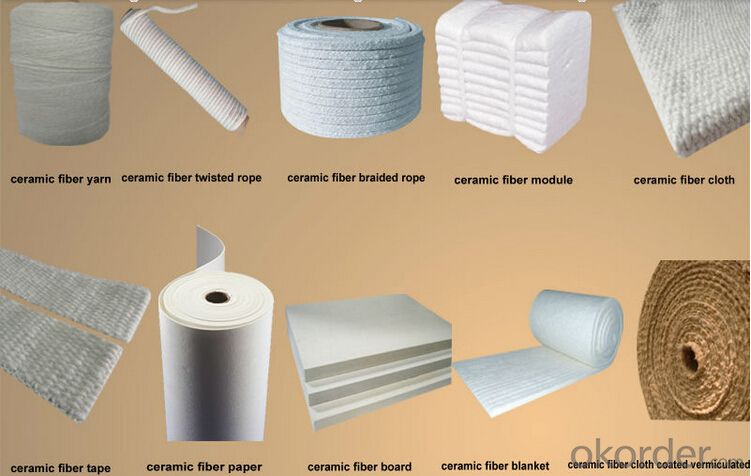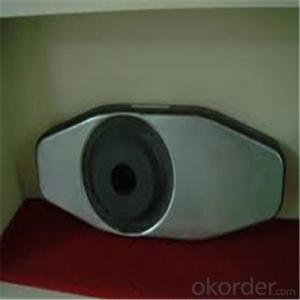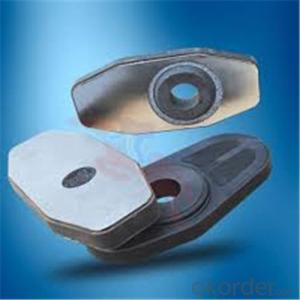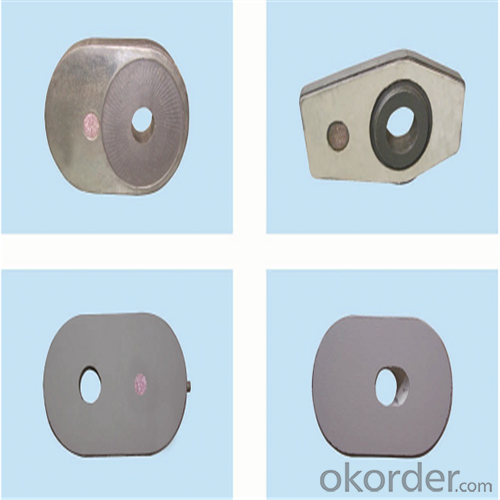Monolithic Refractories Ladle Sliding Gate for Iron and Steel Industry 2024
- Loading Port:
- Shanghai
- Payment Terms:
- TT OR LC
- Min Order Qty:
- 100 pc
- Supply Capability:
- 1000 pc/month
OKorder Service Pledge
OKorder Financial Service
You Might Also Like
Quick Details for High Performance Refractory Ladle Slide Gate
| Place of Origin: | China (Mainland) | Shape: | Plate | Material: | Alumina Block |
| SiO2 Content (%): | N/A | Al2O3 Content (%): | 80-90% | MgO Content (%): | N/A |
| CaO Content (%): | N/A | Refractoriness (Degree): | 1770°< Refractoriness< 2000° | CrO Content (%): | N/A |
| SiC Content (%): | N/A | Model Number: | CS80 | Brand Name: | |
| Product name: | High performance refractory ladle slide gate | Model No.: | cs80 | Brand name: | CMAX |
| Quality: | Al-C or Al-Zr-C | Service life: | 4-6 heats | Apparent porosity: | 7% Max |
| Bulk density:: | 3.1 MIN | C.C.S: | 120MPA | MOQ: | 100 pcs for trial |
| Delivery time: | 60 working days upon receipt of deposit |
Packaging & Delivery
| Packaging Details: | Inner carton packing, outer wooden case suitable for long term sea shipping |
| Delivery Detail: | three months working days upon receipt of deposit |
Specifications
Surface flatness less than 0.05mm
High mechanical strength
Erosion resistance
Oxidation resistance
Thermal shock stability
General Chemical Analysis for refractory ladle slide gate :
slide gate plate widely including Alumina carbon and Alumina Zirconia Carbon slide gate plate, MgO and MgO-spinel slide gate plate,nonoxides bonding slide gate plateand unburned slide gate plate.
Alumina -Zirconia-Carbon material
| Al-Zr-C Material | |||||
| Al2O3 | C | ZrO2 | Apparent porosity | Bulk density | C.C.S |
| (% minm) | (% minm) | (% minm) | (% max) | (gm./cc minm) | (MPa minm) |
| 85 | 3 | 5 | 7 | 3.1 | 120 |
| 85 | 3 | 4 | 7 | 3.1 | 120 |
Composite type: Al-Zr-C for working line, outer Al-C material


| Al-Zr-C & Al-C Material | ||||||
| Al2O3 | C | ZrO2 | Apparent porosity | Bulk density | C.C.S | |
| (% minm) | (% minm) | (% minm) | (% max) | (gm./cc minm) | (MPa minm) | |
| Inner side (Working face) | 85 | 3 | 4 | 7 | 3.1 | 120 |
| Outside | 90 | 3 | 0 | 9 | 3 | |
Using the raw materials of tabular alumina, zirconia-corundum, carbon and other high-grade additives, after sintering to obtain characteristics of oxidation resistance, scour strength, erosion resistance, thermal shock resistance, shape stable and long service life, made our products the preferred materials for the large and medium-sized steel ladle, refining ladle, series of alloy steel ladle, and tundish. Our high performance sintering sliding gates include alumina carbon , Al2O3-ZrO2-C, etc, can meet the needs of different steel grade.
Other Products


About us


Sample is on your request.
Welcome to visit our factory~
- Q: How do monolithic refractories withstand the corrosive environments in steelmaking processes?
- Monolithic refractories withstand corrosive environments in steelmaking processes due to their high chemical resistance and thermal stability. These refractories are made from a single, continuous material, eliminating joints and weak points that can be susceptible to corrosion. They are composed of materials such as high-alumina, silica, or magnesia, which possess excellent resistance to chemical attacks from molten metals, slags, and gases present in steelmaking. Additionally, monolithic refractories can be designed with specific additives and binders to further enhance their resistance to corrosion, ensuring their durability and prolonged service life in the harsh conditions of steelmaking processes.
- Q: How do monolithic refractories contribute to the overall efficiency of ladle refining processes?
- The overall efficiency of ladle refining processes is greatly enhanced by the use of monolithic refractories. Ladle refining, a critical step in steelmaking, involves the removal of impurities and the addition of alloying elements to achieve the desired steel properties. Unshaped refractory materials, known as monolithic refractories, offer numerous benefits that contribute to the efficiency of this process. To begin with, monolithic refractories provide excellent thermal insulation. As ladle refining processes involve high temperatures, it is crucial for the refractories to withstand and contain these temperatures. Monolithic refractories have a low thermal conductivity, which minimizes heat loss from the ladle. This insulation helps maintain the desired temperature within the ladle, enabling efficient refining and reducing the energy required for heating. Furthermore, monolithic refractories exhibit high resistance to chemical attack and erosion. During ladle refining, the steel is exposed to various chemical reactions and corrosive elements. Monolithic refractories are specifically designed to withstand these harsh conditions, effectively protecting the ladle from chemical attack and erosion. This resistance ensures that the refractories maintain their structural integrity, preventing any contamination of the steel and extending the lifespan of the ladle. Additionally, monolithic refractories offer easy installation and repair. Unlike traditional brick refractories, monolithic refractories can be applied as a single, homogeneous layer, eliminating the need for complex bricklaying techniques. This ease of installation reduces downtime during ladle maintenance and repair, thus improving the overall efficiency of the refining process. Moreover, monolithic refractories can be easily patched or repaired as needed, further minimizing downtime and ensuring continuous operation. In conclusion, monolithic refractories play a significant role in enhancing the overall efficiency of ladle refining processes. Their exceptional thermal insulation properties, resistance to chemical attack and erosion, and ease of installation and repair all contribute to improving the efficiency and productivity of ladle refining. By providing a reliable and durable lining for the ladle, monolithic refractories help maintain the desired temperature, prevent contamination, and minimize downtime, ultimately resulting in improved quality and yield of the refined steel.
- Q: How are monolithic refractories recycled or disposed of at the end of their lifespan?
- Monolithic refractories, widely utilized in high-temperature industrial applications, offer various means of recycling or disposal once their lifespan concludes. The preferred approach depends on the specific monolithic refractory type and its composition. Reclamation stands as a common method for recycling monolithic refractories. This process entails collecting used refractory materials and subjecting them to processing to eliminate any impurities or contaminants. The resultant reclaimed refractory material can then be crushed, ground, or milled into a fine powder suitable for utilization as a raw material in manufacturing new refractories. Thermal treatment represents an alternative means of recycling monolithic refractories. This method involves exposing the used refractory material to high temperatures within a controlled environment, such as a kiln or furnace. The heat effectively breaks down the refractory material, eliminating any binders or impurities. The resulting material can then be reused as a raw material or integrated into other applications, such as construction aggregates. When recycling is not feasible, specialized facilities designed for handling and treating hazardous waste offer a disposal avenue for monolithic refractories. These facilities ensure the proper containment and treatment of the refractory material, minimizing any potential environmental impact. This disposal method is typically reserved for refractories containing hazardous substances or those that cannot be recycled due to their composition. It is important to emphasize that the appropriate disposal or recycling method for monolithic refractories must adhere to local regulations and guidelines. These regulations aim to ensure the safe handling, treatment, and disposal of these materials, taking into account their potential environmental and health effects. Therefore, industries and businesses must collaborate closely with waste management professionals and adhere to the appropriate procedures to responsibly manage monolithic refractories at the end of their lifespan.
- Q: How do monolithic refractories improve the efficiency of ladle and tundish preheating furnaces?
- Monolithic refractories play a crucial role in improving the efficiency of ladle and tundish preheating furnaces. These refractories are made from a single material and are designed to be easily installed, repaired, and replaced, making them highly versatile and cost-effective. One of the main ways monolithic refractories contribute to the efficiency of these furnaces is through their excellent thermal insulation properties. These refractories have low thermal conductivity, which means they can effectively retain heat and prevent it from escaping the furnace. This insulation capability minimizes heat loss and ensures that the preheating process is carried out efficiently, reducing energy consumption and costs. Furthermore, monolithic refractories have high thermal shock resistance, which is crucial in ladle and tundish preheating furnaces. These furnaces are subjected to rapid temperature changes when molten metal is poured into them, and this can cause conventional refractories to crack or fail. However, monolithic refractories are designed to withstand thermal shock, ensuring that they remain intact and maintain their insulating properties even under extreme conditions. This durability enhances the overall efficiency of the preheating process by reducing downtime and maintenance requirements. Moreover, monolithic refractories provide a smooth and uniform lining surface, which helps to improve heat transfer within the furnace. The absence of joints or seams reduces the risk of heat leakage and ensures that heat is evenly distributed throughout the lining. This promotes uniform heating of the ladle or tundish, allowing for more efficient preheating and better control of the temperature. In summary, the use of monolithic refractories in ladle and tundish preheating furnaces results in improved efficiency due to their excellent thermal insulation properties, high thermal shock resistance, and ability to provide a smooth and uniform lining. These refractories help to minimize heat loss, reduce energy consumption, and enhance the overall performance of the preheating process.
- Q: What are the key properties of ramming mixes used for monolithic refractory installations?
- The key properties of ramming mixes used for monolithic refractory installations are: 1. High thermal stability: Ramming mixes should possess high thermal stability to withstand the extreme temperatures and thermal cycling in refractory applications. This property ensures that the ramming mix remains intact and does not undergo significant structural changes under varying thermal conditions. 2. High density: Ramming mixes need to have a high density to provide good resistance against thermal conductivity. This property helps in minimizing heat loss and maintaining the desired temperature in the refractory lining. 3. Low porosity: Low porosity is essential for ramming mixes as it helps in reducing the penetration of molten metals or slag into the refractory lining. This property enhances the overall durability and longevity of the refractory installation. 4. Good mechanical strength: Ramming mixes should possess good mechanical strength to withstand the stresses and loads encountered during installation, as well as during the operation of the refractory lining. This property ensures that the ramming mix can resist any physical or mechanical damage, such as cracking or spalling. 5. Chemical resistance: Ramming mixes should exhibit excellent resistance to chemical attack from molten metals, slag, or corrosive gases. This property is crucial for protecting the refractory lining from chemical reactions and degradation, which can compromise its performance and lifespan. 6. Easy installation and workability: Ramming mixes should have good workability, allowing for easy installation and compaction. This property ensures that the mix can be easily shaped and rammed into place without excessive effort or time, facilitating efficient and effective refractory installations. 7. Controlled setting time: Ramming mixes should have a controlled setting time to allow sufficient time for proper placement and consolidation. This property ensures that the mix remains workable during installation but sets and hardens within a reasonable time frame, allowing for timely completion of the refractory lining. In summary, the key properties of ramming mixes used for monolithic refractory installations include high thermal stability, high density, low porosity, good mechanical strength, chemical resistance, easy installation and workability, and controlled setting time. These properties collectively contribute to the overall performance, durability, and longevity of the refractory lining in various high-temperature applications.
- Q: What are the advantages of using plastic refractories in the iron and steel industry?
- There are several advantages of using plastic refractories in the iron and steel industry. Firstly, plastic refractories have excellent thermal shock resistance, which means they can withstand rapid changes in temperature without cracking or breaking. This is crucial in the iron and steel industry where the materials are exposed to extreme heat during the manufacturing process. Secondly, plastic refractories have good workability and can be easily shaped and molded to fit various complex shapes and sizes of furnaces, ladles, and other equipment used in the industry. This makes them highly versatile and adaptable to different production requirements. Additionally, plastic refractories have excellent resistance to chemical attacks from molten metals and slags. They can withstand the corrosive nature of these materials and maintain their structural integrity, ensuring longer service life and reducing maintenance costs. Lastly, plastic refractories have good bonding properties, allowing them to adhere well to existing refractory linings. This helps to extend the lifespan of the overall refractory system and reduce the need for frequent repairs or replacements. Overall, the advantages of using plastic refractories in the iron and steel industry include thermal shock resistance, workability, chemical resistance, and good bonding properties, making them a preferred choice for lining and repairing furnaces and other equipment in this industry.
- Q: What are the key properties of gunning mixes used for monolithic refractory repairs?
- The key properties of gunning mixes used for monolithic refractory repairs include: 1. High durability: Gunning mixes should have excellent resistance to thermal shock, abrasion, and chemical attack. This ensures that the repaired refractory material can withstand the harsh conditions in industrial furnaces and kilns. 2. High strength: Gunning mixes should have a high compressive strength to provide structural integrity to the repaired refractory lining. This is especially important in areas that are subjected to high mechanical stress or load. 3. Easy application: Gunning mixes should have good gunning properties, allowing for easy and efficient application. They should have the ability to be sprayed or gunned onto the surface to be repaired, providing a smooth and even coating. 4. Quick setting and drying: Gunning mixes should have a fast setting and drying time to minimize downtime during repairs. This ensures that the repaired refractory lining can be quickly put back into service, reducing production losses. 5. Good adhesion: Gunning mixes should have excellent adhesion to the existing refractory material. This ensures a strong bond between the new repair material and the old lining, preventing any potential delamination or separation. 6. Thermal stability: Gunning mixes should have a high resistance to thermal cycling and temperature fluctuations. They should be able to maintain their structural integrity and mechanical properties even under extreme heat conditions. 7. Chemical compatibility: Gunning mixes should be chemically compatible with the materials they come into contact with, such as molten metals or corrosive gases. This ensures that the repaired refractory lining can withstand the corrosive effects of these substances. Overall, the key properties of gunning mixes for monolithic refractory repairs are focused on providing durability, strength, easy application, quick setting, good adhesion, thermal stability, and chemical compatibility. These properties ensure that the repaired refractory lining can effectively withstand the harsh operating conditions in industrial furnaces and kilns, prolonging their lifespan and reducing maintenance costs.
- Q: How do monolithic refractories resist chemical attacks from molten metals and slag?
- Monolithic refractories resist chemical attacks from molten metals and slag due to their high chemical stability, which is achieved through the use of carefully selected raw materials and advanced manufacturing processes. These refractories are designed to have low porosity, which prevents the penetration of molten metals and slag into the material. Additionally, they possess high resistance to corrosion and erosion, even at high temperatures, allowing them to withstand the harsh chemical environments created by molten metals and slag.
- Q: How do monolithic refractories perform in high-temperature environments?
- Monolithic refractories are highly effective in high-temperature environments due to their unique characteristics. These refractories are made from a single, continuous composition, as opposed to being composed of multiple bricks or tiles. This monolithic structure provides several advantages when it comes to performance in high-temperature conditions. Firstly, monolithic refractories have excellent thermal shock resistance. This means that they can withstand rapid temperature changes without cracking or spalling. High temperatures can cause significant stress on materials, but the monolithic structure allows for better expansion and contraction, reducing the risk of damage. Additionally, monolithic refractories have high resistance to chemical attack. In high-temperature environments, there are often aggressive chemical agents present that can corrode and erode traditional refractory materials. However, the monolithic composition is usually designed to be chemically inert, providing a protective barrier against these corrosive elements. Moreover, monolithic refractories offer superior strength and durability at high temperatures. Their single composition ensures a dense and compact structure, making them less prone to cracking or breaking under extreme thermal conditions. This strength allows them to maintain their integrity and performance even in the most demanding environments. Furthermore, monolithic refractories can be easily installed and repaired. Unlike traditional refractories, which require precise brick or tile placement, monolithic materials can be poured or sprayed into place, conforming to any shape or size. This flexibility makes installation faster and more cost-effective, reducing downtime and maintenance costs. Overall, monolithic refractories excel in high-temperature environments due to their thermal shock resistance, chemical inertness, durability, and ease of installation. Their ability to withstand extreme heat and harsh conditions makes them a preferred choice for industries such as steel, cement, glass, and petrochemicals, where high temperatures are common.
- Q: What are the latest advancements in monolithic refractories for the iron and steel industry?
- Enhanced properties have been achieved in the latest advancements of monolithic refractories for the iron and steel industry. These advancements are aimed at withstanding the extreme temperatures and harsh conditions associated with iron and steel production processes. One notable advancement is the utilization of advanced bonding systems that offer exceptional strength and resistance to thermal shock. These systems, including nano-bonding technology, contribute to the overall improvement in the performance and durability of monolithic refractories. Another significant development is the introduction of low cement castables. These castables contain a reduced amount of cement, resulting in enhanced high-temperature strength and erosion resistance. This advancement proves particularly valuable in applications within the iron and steel industry where thermal cycling and mechanical stress are common. Furthermore, the composition of monolithic refractories has seen advancements. The incorporation of advanced raw materials, such as high-quality aggregates and additives, has led to improved thermal conductivity, corrosion resistance, and thermal insulation properties. These developments allow for more efficient and sustainable iron and steel production processes. Additionally, recent advancements have been focused on the development of self-flow castables. These castables possess excellent flowability, facilitating easy installation and maintenance of refractory linings. This advancement not only reduces installation time and costs but also ensures improved lining performance. In conclusion, the latest advancements in monolithic refractories for the iron and steel industry have resulted in improved performance, durability, and efficiency. These advancements enable the industry to enhance its production processes, minimize downtime, and increase overall productivity.
Send your message to us
Monolithic Refractories Ladle Sliding Gate for Iron and Steel Industry 2024
- Loading Port:
- Shanghai
- Payment Terms:
- TT OR LC
- Min Order Qty:
- 100 pc
- Supply Capability:
- 1000 pc/month
OKorder Service Pledge
OKorder Financial Service
Similar products
Hot products
Hot Searches
Related keywords





























